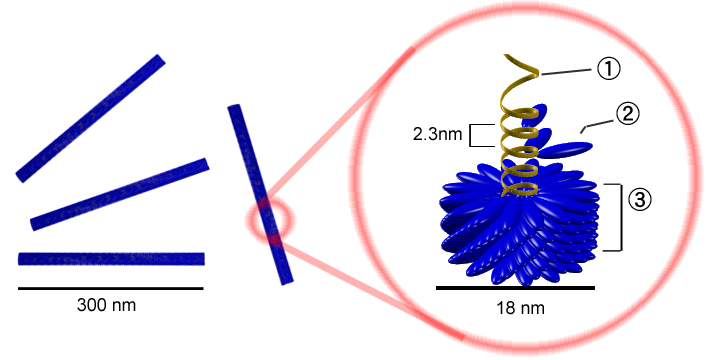Tobacco mosaic virus
Template:Taxobox begin Template:Taxobox image Template:Taxobox begin placement Template:Taxobox regnum entry Template:Taxobox norank entry Template:Taxobox genus entry Template:Taxobox species entry Template:Taxobox end placement Template:Taxobox end
Tobacco mosaic virus (TMV) is an RNA virus that infects plants, especially tobacco and other members of the family Solanaceae, showing characteristic patterns (mottling and discoloration) on the leaves (thus the name). It was the first virus to be discovered. Although it was known from the late 19th century that something was threatening tobacco crops, it was not until 1930 that the cause was identified as a virus.
History
In 1883 Adolf Mayer first described the disease that could be transferred between plants, similar to bacterial infections[1]. However, in 1889, Martinus Beijerinck showed that a filtered, bacteria-free culture medium still contained the infectious agent[2]. Dimitri Ivanovski gave the first concrete evidence for its existence in 1892. In 1935, Wendell Meredith Stanley crystallized the virus for electron microscopy and showed that it remains active even after crystallization[3]. For his work, he was awarded 1/4 of the Nobel Prize in Chemistry in 1946[4]. In 1955, Heinz Fraenkel-Conrat and Robley Williams showed that purified TMV RNA and its capsid (coat) protein assemble by themselves to functional viruses, indicating that this is the most stable structure (the one with the lowest free energy), and likely the natural assembly mechanism within the host cell.
The crystalographer Rosalind Franklin worked for Stanley for about a month at Berkeley, and later designed and built a model of TMV for the 1958 World's Fair at Brussels. In 1958, she speculated that the virus was hollow, not solid, and hypothesized that the RNA of TMV is single-stranded. This conjecture was proven to be correct after her death and is now know to be the + strand.
Structure

Tobacco mosaic virus has a rod-like appearance. Its capsid is made from 2130 molecules of coat protein (see image above) and one molecule of genomic RNA 6390 bases long. The coat protein self assembles into the rod like helical structure (16.3 proteins per helix turn) around the RNA which forms a hairpin loop structure (see Electron Micrograph below). The protein monomer consists of 158 aminoacids which are assembled into four main alpha-helices, which are joined by a prominent loop proximal to the axis of the virion. Virions are ~300 nm in length and ~18 nm in diameter.[5] Negatively stained electron microphotographs show a distinct inner channel of ~4 nm. The RNA is located at a radius of ~6 nm and is protected from the action of cellular enzymes by the coat protein. There are three RNA nucleotides per protein monomer.[6]
Scientific and Environmental Impact
In plants, tobacco mosaic virus leads to severe crop losses[7]. It is known to infect members of nine plant families, and at least 125 individual species, including tobacco, tomato, pepper, cucumbers, and a number of ornamental flowers.[8] There are many different strains.
The large amount of scientific literature about TMV and its choice for many pioneering investigations in structural molecular biology, X-ray diffraction, virus assembly and disassembly, and so on, are fundamentally due to the large quantities that can be obtained, plus the fact that it does not infect animals. After growing a few infected tobacco plants in a greenhouse and a few simple laboratory procedures, a scientist can easily produce several grams of virus. As result of this, TMV can be treated almost as an organic chemical, rather than an infective agent.[citation needed]
Further reading
- Creager, Angela N. The Life of a Virus: Tobacco Mosaic Virus as an Experimental Model, 1930-1965. Chicago, IL: University of Chicago Press, 2002.
References
- ↑ http://www.apsnet.org/education/feature/TMV/pdfs/zaitlin.pdf
- ↑ http://www.apsnet.org/education/feature/TMV/pdfs/zaitlin.pdf
- ↑ http://www.apsnet.org/education/feature/TMV/pdfs/zaitlin.pdf
- ↑ http://nobelprize.org/nobel_prizes/chemistry/laureates/1946/stanley-bio.html
- ↑ Stryer, Lubert (1988). Biochemistry. Third Edition. W. H. Freeman and Company. ISBN 0-7167-1843-X.
- ↑ Klug, Aaron (March 1999). "The tobacco mosaic virus particle: structure and assembly". Philosophical Transactions of the Royal Society B: Biological Sciences. 354 (1383): 531–535.
- ↑ http://www.ces.ncsu.edu/depts/pp/notes/oldnotes/tb1.htm
- ↑ http://www.extension.umn.edu/distribution/horticulture/DG1168.html
External links
- TMV-Structure, Replication,Infection
- Description of plant viruses - TMV - contains information on symptoms, hosts species, purification etc.
- [1] Further information
- [2] Electron microscope image of TM
de:Tabakmosaikvirus he:מוזאיקת הטבק lt:Tabako mozaikos virusas sk:Vírus tabakovej mozaiky Template:WikiDoc Sources